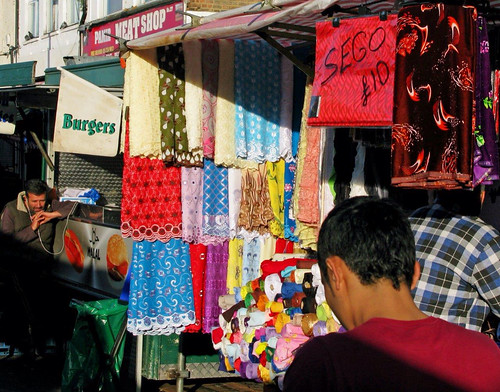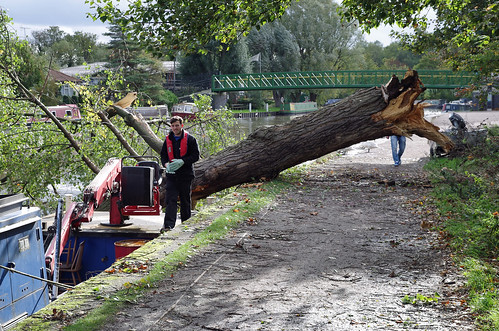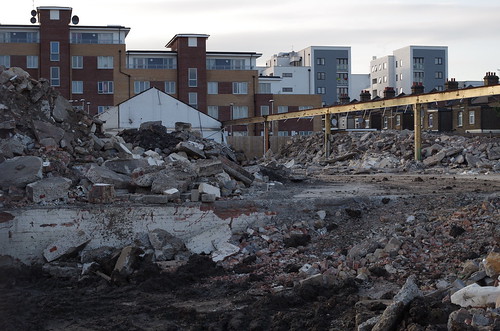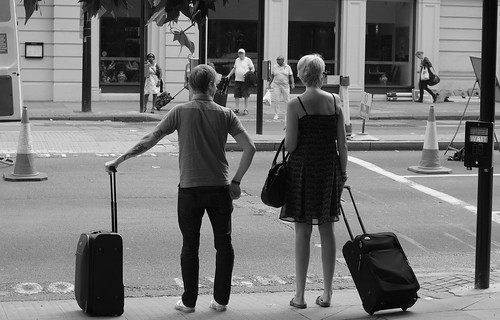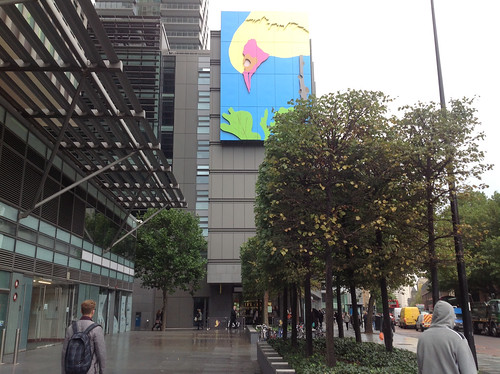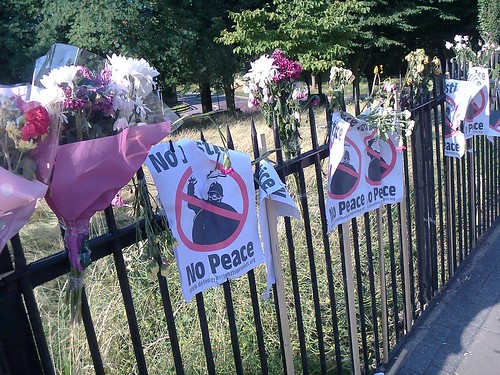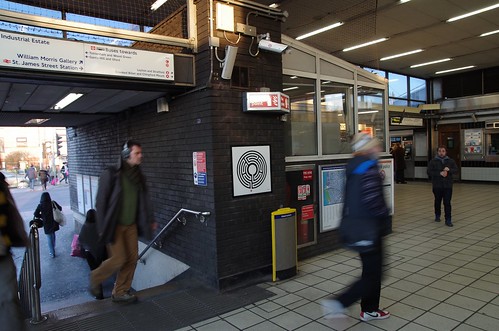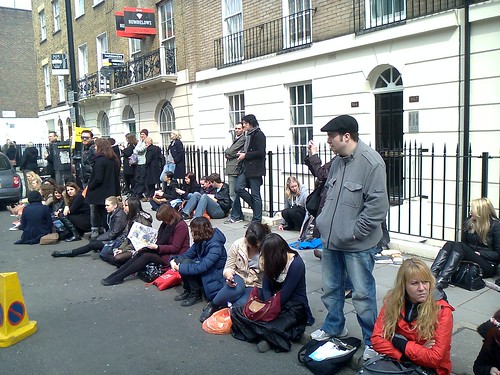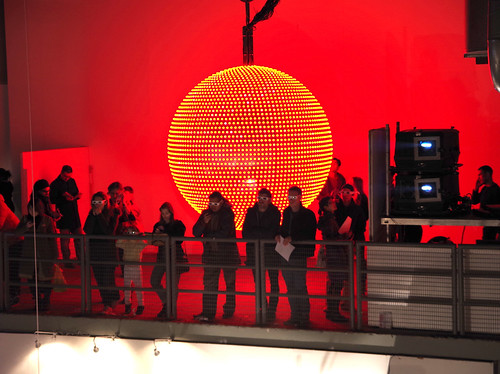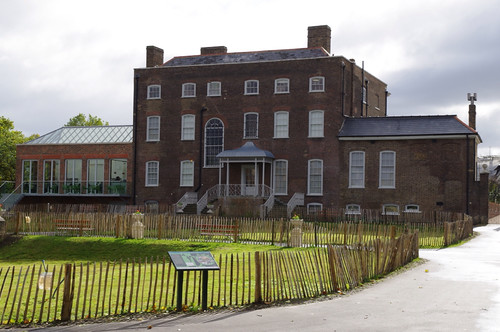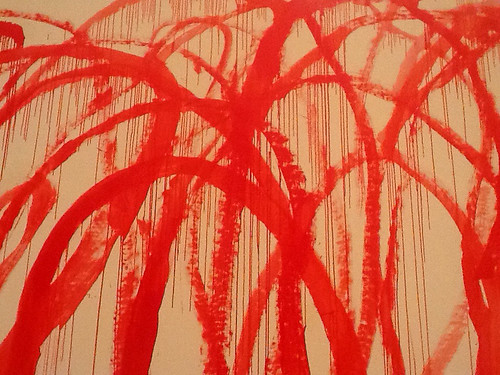Saturday, 16 November 2013
A moment's reflection
Tuesday, 5 November 2013
Carol Ann Duffy in Walthamstow
If the Nazis had invaded Britain, they would have earmarked Walthamstow Assembly Hall as their kind of architecture: a severely plain neoclassical front with impossibly tall columns. Not the only use for that sort of building of course, but it was slightly strange to approach on a dark and windy evening, with light streaming out of those tall windows and crowds of people hurrying to get in, for the evening of poetry lined up. And not just any old poetry reading: the place holds 800 and it filled up.
The event was billed "an audience with Carol Ann Duffy with music by John Sampson". But first up was Warsan Shire, the new Young Poet Laureate for London, perhaps not announced beforehand because the appointment is so recent. She stood behind the lectern, striking in a simple black dress and giant frizzed-out hair, and read three poems with just a line or so of explanation. Strong stuff that deserves to be read in print too, to get a better understanding of those alarming images she deals with.
Carol Ann Duffy has a dry sense of humour and her poetry is of course a pleasure to read, as it was to hear her read it. Pieces from The World's Wife remain a strong part of her output. We got a little insight into the meaning behind some familiar pieces, the odd throwaway lines (Mrs Icarus) and even a couple of unpublished pieces. Although she is the Poet Laureate, the title carries no job description and she evidently feels under no obligation to write about the royal family. Making fun of Nick Clegg (like Faust, selling his soul to the devil) comes no closer to an official line, thank goodness.
This main part of the event was set up as a double act with the above mentioned John Samson. A big man in a three-piece suit, he does a sort of foolish musical comedy act, playing a variety of very small pipes mainly for comic effect. He can play very fast and typically throws in a few drawn-out bum notes for a laugh. "The Queen didn't want him so she gave him to me" quipped Duffy dismissively, but in fact she's been performing with him for a least ten years so the apparent indifference is just part of the act. There was little sign of rapport between the two, but she had him play along to a couple of the poems, so we have to assume her deadpan demeanour and his funny noises are an intentional combination. Perhaps he is there to illustrate her conviction that men are basically useless. Actually, a fair part of the audience was amused - they clapped along and even sang to a rendition of the Isle of Skye (or perhaps it was Mull of Kintyre) - but not everyone was pleased with this diversion from the main attraction. I just wished she would stick to reading.
This is the 100th post on London Sidelines. A milestone, or time for something new? Click on the post title to go to the comments form.
Monday, 28 October 2013
After the storm
A fallen tree blocking the towpath of the Lea Navigation canal in east London. One of many trees blown over by high winds on the night 27/28 October, euphemistically tagged Stormageddon on Twitter. The British Waterways man had come with a small crane but it was obviously hopelessly undersized for the job.
Tuesday, 22 October 2013
Street photography
Sometimes it all comes together. The guy on his bike, not just any old bike but quite a nice singlespeed with leather saddle and matching leather handlebar tape. Plus a fashionable canvas bag with leather trimmings. But also in the background, that character outside the Japanese Canteen perfectly silhouetted against the rectangle of white, dressed with un-missable bravado and swigging from a can of Coke. You can't plan a shot like this, it's just there and either you get it or you don't. It could have been better focused but at least you can see what's going on. Usually it's gone before you can even think about pointing a camera. Having a camera in your hand helps but the odds are, if you're trying to take photos you walk for an hour and see nothing really worth photographing, take a few shots and delete them later. Other times you just have the camera in case, not really planning to take photos but just out of habit, and something makes you switch it on and point just at the right moment. You could drive yourself crazy always being on the lookout for an interesting shot, better just to carry a camera and see what turns up without looking for it.
Sunday, 20 October 2013
Housing boom
After a bit of a hiccup, otherwise known as the recent recession, the frenzy of housebuilding seems to be back in a big way. Along the Lea Valley in east London, the old factories are disappearing one by one, most of them simply bulldozed to clear the site for this kind of architecture-by-numbers apartment blocks. These are fairly typical, built on an industrial area in Walthamstow. There is the usual depressing split between the market apartments, which are quite nicely laid out, and the so-called affordable part which looks a bit like an open prison. Integrating the two is a common aspiration and if I've understood correctly the same developer has done that successfully elsewhere - but that doesn't necessarily happen. It's very much easier to resolve the differences by splitting the site.
In the foreground, another factory bites the dust. There are two problems with all this - firstly, one of those old terraced houses that surround this site are almost certainly what people really want but are now becoming unaffordable, and secondly, those old factories provide affordable business premises which are not getting replaced. Things do have to change, but you can't help wondering how it will work out in the long term.
Thursday, 17 October 2013
Win an iPad?
It could be a caption competition. Think up a catchy caption and the best submission wins an iPad. All entries must be in by 25 October. Answers on a postcard, a real postcard with a stamp on it, not a virtual one. However I'm not really offering a prize, just thought I would post this photo of a rather charming pair of visitors to London, trying to get across six lanes of traffic on the Euston Road.
Monday, 14 October 2013
Watch the birdie
The residential tower, though, is quite possibly the ugliest tower in London, a grim grey structure that looks puny situated as it is alongside the no-frills bulk of Euston Tower (once the home of Capital Radio). A relatively low-rise block of flats along Hampstead Road was designed by the same architect. Come rain or shine, that overall matt grey finish and the complicated balconies do nothing to make the building seem friendly. The final touch, perhaps, is this surprising but not entirely welcome image of a bird fixed high up on the facade. Maybe there will be more of the same, but for now there is just the one. The artwork is by Gary Hume, the YBA who does extremely simple paintings using domestic gloss paint, so simple there is little to appreciate except I suppose a certain degree of abstraction. Here we get a biggish bird, some leaves and a stick, or at least it looks like a stick, although one's first thought is that it's badly drawn leg. Perhaps there are art world characters who think this is an achievement, but it seems perfectly valid to call it an unfortunate bad decision. If not something ruder.
There used to be a giant mural by Michael Craig-Martin on the site, not in the same place but nearby - a pop-art image of an electric fan, several storeys high and lit up at night. It didn't appear to have any particular relevance but it was quite nice as a landmark. The bird doesn't come close to replacing it.
Monday, 19 August 2013
No Justice, No Peace
'No Justice, No Peace' read the placards at the spot where Mark Duggan was shot. For the first few weeks after the event there were masses of flowers and cards attached to the railings, and then that was all cleared away and nothing was left but bare railings. Recently, around the second anniversary, and with the subject still in the news, this little display sprang up. That phase comes from the LA riots in 1992, and it's found various uses since. Already, the flowers and placards are gone, leaving just the sticks sellotaped to the railings. Maybe it's best that the spot remains unmarked, although the shooting and subsequent riots will stick in the collective memory for a long time.
Monday, 12 August 2013
Summer
Summer is for being out of doors, not sitting in front of a screen. Even if it looks like it might rain.
Tuesday, 11 June 2013
Lost in the labyrinth
This is one of many vitreous enamel plaques that have recently appeared in tube stations, looking oddly official, perhaps because enamelled steel is used for most of the Tube maps and signs. They are in fact works of art, perhaps something to make up for the advertising excesses on the Underground. There will be 270 plaques when the project is completed, with a different design on each. They are all similar - a black labyrinth on a white background with a small red detail and a number - but each is unique. The designs, and presumably the original idea, are by artist Mark Wallinger, perhaps best known for his contribution to the Fourth Plinth, a naked figure with a crown of barbed wire (apparently - I completely missed it and just found that on Wikipedia). Nice to see cash-strapped London Underground can still spend money on art, and can still do it this well.
Saturday, 4 May 2013
Through a glass darkly
This strikingly striped taxi is a moving advert for budget fashion accessory chain Aldo, spotted from a bus going up Tottenham Court Road. The taxi overtook the bus, and then both obligingly slowed down just as I got my camera adjusted. The design is one of several by graphic designer Malika Favre, all featuring geometric backgrounds and a face with sunglasses. I dont think it depicts anything specific that Aldo actually sells. Coordinated cycle chic types might think, matching yellow sun specs to go with my yellow bike, but they don't really have them in bright colours.
Photo-based graphics on vehicles is a bit of a trend, printed on flexible plastic film that moulds to the contours of the bodywork. This one works because it's simple and emphasises the pleasing curves of the London taxi. Others are nastier: the Sky vans with lurid photos of TV shows are particularly ugly. There's a lorry I see regularly, printed to look like an oversized wooden crate of potatoes. Sometimes you might wish all vehicles were dignified dull colours with discreet lettering in a nice serif font, preferably gold, like the old Hovis ads. But of course in those days the streets were actually plastered with painted signs on house ends, shopfronts, billboards and sandwich-man boards, buses and commercial vehicles, you name it, huge lettering shouting out trade names and unproven claims. Even more visual clutter than we have today, apparently unregulated and completely lacking in wit or irony. Some of those old signs survive, washed out half-readable remnants left to fade away quietly. The Aldo shrink-wrap, on the other hand, may be here today but it will be gone forever tomorrow.
Sunday, 21 April 2013
Another Thursday, another lunchtime recital
18th April: Zoe Lethbridge - flute and Julian Collings - organ, perform a programme of original works for flute and organ including works by Frank Ferko and JS Bach.
Looking at the options as one o'clock approaches, there's a choice between a single concerto by Brahms at Munster Square, or a selection of pieces for organ and flute at St Pancras Parish Church. The organ is obviously a more enticing prospect. St Pancras recitals start when the church clock strikes a quarter past one, so there's time to get there without bunking off work early, and collect the handout with a couple of minutes to spare. It's up there, the white-haired gent on duty tells everyone as they come in, pointing at an apparently empty corner of the balcony. You'll have to twist round in your seat to see.
That makes for a very odd concert and might explain why people are walking out as well as in. Usually the place is reasonably full, not full as in every seat taken, but maybe fifty people or so. Today the number stabilises at just nineteen people, including me and the man in charge, scattered around the place. Some of them actually are twisted round to see something, but mainly they are just sitting and listening. That's one approach to music: sit well back, maybe close your eyes, and absorb the music. The architecture of the church is interesting, so at least there is something to look at. What I like though, is to watch the performers and get a visual sense that the music doesn't just exist in a vacuum: to actually see the concentration and skill that go into making it happen. The way things are set up this time, that experience is tantalisingly close but never quite realised.
Up in the gallery, where the public isn't allowed to sit, is the organ and the keyboard console, which is a big wooden box set away from the organ pipes, with the organist completely hidden behind it. Our flute player is almost visible, a willowy figure with crazy long hair, but she's hiding behind the music stand and most of the time all you can see is knees and the end of the flute. After a while I get up and walk along the side aisle to see if there is a better viewpoint. There isn't. Once the organ gets going, though, the music makes up for all that.
Sunday, 14 April 2013
Lunchtime recital at St Mary Magdalene Munster Square
For me, it's a touch of the unexpected magic that sometimes happens when you go to a recital knowing nothing about the performers or the music, and find yourself not wanting the moment to end. The songs have lurid titles: "I cannot grasp or believe it", "He, the noblest of all", "Now you have caused me pain for the first time". She explains the story of some of the them: Strauss's 'Die Nacht', she tells us, is about a woman and "her fears that the creeping shadows of the night, that steal away all colour and life from her room, will also steal away her lover..." Romantic histrionics, then, best appreciated in a language you don't understand. My sandwich remains half-wrapped, uneaten until it's time to go outside into the rain.
Thursday, 11 April 2013
Sherlock Holmes's new case
Wednesday morning in North Gower Street: some unusually large white vans, unmarked, are parked on both sides, and the road is partly closed. Curious passers-by linger for a moment but there's nothing to see. By lunchtime though, there is quite a buzz of excitement, although there's still nothing much happening. The vans evidently belong to a film crew and some equipment is getting set up. There's a boom but no camera so I don't really look any closer. Part of the pavement is marked with bollards and a sign warns, if you enter this zone you implicitly agree to be an unpaid extra, although that's not quite how it's worded.
Word of the filming must have spread because there is a small crowd strung out on the east side of the street, waiting to see what will happen. The pub around the corner provides a clue with the chalked message "tweeds and deerstalkers welcome". Something to do with the Tweed Run, the vintage cycling event? No, I realise - of course it's the return of the TV series that was filmed here last year and the year before. But it's lunchtime and what I actually want is a sandwich, as fast as possible, to take to one of those tedious lunchtime meetings. It's a bit past one so I'm late already, but the Piccolo Sandwich Bar and Cafe down the side street is quieter than usual, and my sandwich is ready fast enough. A generator truck sits outside the cafe, some kind of offload vehicle with huge wheels, completely unnecessary in this setting but rather impressive. There's still no sign of a camera let alone anyone famous so I head off to my meeting, where we will learn how to use the new user-friendly image database.
North Gower Street is home to Speedy's, better known as the cafe next door to Sherlock Holmes's flat in the BBC television series. Baker Street itself is far too grand and touristy to be used as the location and the shabby Georgian terraces of this out-of-the-way street, just around the corner from Euston station, serve the purpose much better. It's also a lot easier to close off to traffic without seriously affecting a whole area of central London. Speedy's is good for bacon sandwiches but otherwise a bit of a dump, one of those cafes that remain in a 1950s timewarp and might do better to clear the place out and start afresh.
There was a bigger crowd after work, and I expect they did get to see some scenes from the forthcoming series starring Benedict Cumberbatch as Holmes and Martin Freeman as Watson. Personally I hate waiting for anything - buses, people arriving at Heathrow, waiting for toast to turn brown, you name it - so I didn't stick around to find out.
Tuesday, 5 March 2013
Electronic and kinetic art at Ambika P3
Kinetica Art Fair was open over the weekend at Ambika P3, the gigantic underground structures laboratory in the basement of the University of Central London, which was once the Polytechnic of Central London and a hotbed of architectural and structural innovation. The show featured an eclectic assortment of creations ranging from hi-tech to Heath Robinson, but it somehow lacked a defining sense of achievement. There were plenty of fairly amusing things but hardly anything to take your breath away and leave you wondering why that had never been done before.
The entrance to P3 isthrough some kind of maintenance yard, through a narrow doorway where people with tickets were left wondering if they had to join the long queue, or push their way through. Inside, you enter via a balcony overlooking the main space. The smell of frying burgers was not encouraging and the place was too crowded but the space itself is dramatic.
There were some very charming handmade exhibits, slapdash in the best kind of way, made to just about do what they are supposed to do without excess polish. A small tree branch suspended from three concentric rings, with the twigs cut exactly at the line of the rings above them, so the whole thing scrambles, and then reassembles again as a complete branch. Silly stuff like vibrating pictures that you couldn't see properly because of the movement. An old typewriter that no longer typed words, but had a nylon filament connecting each key to one of around forty noise-making devices: arms that struck bottles part-filled with water, a worm drive that sent balls down a chute, each mechanism different and amusingly impractical. The good thing about those was the way you didn't need an explanation, you could just watch and the whole thing was apparent. I didn't mind the tiny sailing boat with a rotating spring mimicking the rise and fall of waves, although that was just a little feeble. There was a beautifully made ball race, sending ping pong balls on twisting wire ramps, taking one of several routes down to the lift mechanism.
A lot of the show was predictable, and the hi-tech tendency which you would think must be the driving force behind this show, turned out to be less sophisticated than you might hope. Mutant robot monsters in the familiar heavy metal mould, a real live model wearing some kind of bondage outfit with robot appendages, stuff made out of bicycle gears. Lots of diffraction effects achieved in different ways. A whole room of effects with lights and mirrors. There was one thing I'd read about beforehand, a shiny cylinder reflecting a strangely-shaped metal blob, the blob being precisely calculated to look like a human hand in the distorted reflection. It worked, and you could see why it worked but that was all it did. Finally, I found something promising, a wooden lay figure about a foot high and next to it a modest array of electronics. The instructions were: stand on the black square with your hands up as the diagram shows. When the machine has finished scanning your body, a red light will show. Then you will be able to control the movements of the lay figure by moving your own body. It was out of order though.
Really, the star of the show was the two-metre metal globe suspended over the balcony from one of the industrial gantries that run across the ceiling. Covered in a grid of lights programmed with an ever-changing display and placed where you can stand right next to it, or see it from the far end of P3: nothing not to like about it.
Sunday, 24 February 2013
David Bailey at the William Morris Gallery
The newly refurbished William Morris Gallery opened in August last year with a bit of a coup, a rare viewing of the 14 metre long Walthamstow Tapestry by Grayson Perry. The place was down at heel, hardly ever open when you'd want to visit and always the same when you did get inside, so a revamp is quite welcome - even if it is perhaps a little too child-friendly. The purpose of the revamp is evidently to shift the gallery up a gear, from local Walthamstow attraction to a place in the London art world. This new exhibition is a selection of images of the East End by sixties icon David Bailey, reinforcing that objective. There are two quite different sets of images in the show, black and white street scenes from 1961, and much larger colour photographs of people in pubs and clubs from 1968. Bailey's photographs portray a world rather different from that same geographical area today.
Gritty, grainy scenes of children playing on bomb sites and tumbledown brick terraces are one part of it, the earlier set. Printed at modest size in high contrast deep black with a black border, they show half-familiar streets with that different life going on. They have a period charm, a kind of photography that was fashionable then and dates them quite separately from the subject matter. He uses that trick of waiting for someone to walk past so as to get a figure in the foreground, or captures his subjects apparently unaware - they might be apologising for getting in front of the camera, but he presses the shutter button precisely where they will be framed against a shop front or a pub window. The children, on the other hand, are obviously keen to strike a pose for the sake of a little attention. The background is relentlessly broken, damaged, worn out. It's almost jarring, then, to see Jean Shrimpton looking like the star she was, posing in an oversized sweater in the dingy hallway of his parents' terraced house. The down-at-heel East End has become such a cliche of the era that it very nearly misses that quality of affording an inside view, a sense of looking back in time and seeing how things really were, but you do get a strong sense of just how much things have changed. Apart from Jean, though, the subject matter is interesting but if you found them in a box of old photographs in a junk shop, you wouldn't think they were anything special.
Those black and white images are set against the seedy nightlife of pubs and private drinking establishments, photographed in washed-out colour and printed much bigger. These are sleazy scenes shot in unglamorous surroundings: peeling paint, cheap furniture and some truly awful wallpaper. Two peroxide blondes with dark eyebrows pose with drinks in hand. A rough-looking geezer with a broken nose, creased clothes and a filthy rag around his neck holds up his dimple glass in one hand, the makings of a roll-up in the other. A couple of characters sit alone in their overcoats, and some men in decent suits are clearly slumming it out east. Last but not least are the Kray twins, blown up life-size and leering evilly, almost comically, holding their twin pet snakes. You wonder what they must have made of David hovering with his camera, but of course he was a local boy and must have known how to fit in, how to talk his way into a crowd, flattering people to get them to pose for the camera. What you don't wonder is what to make of the images: they speak for themselves, showing a huge leap of confidence since those earlier street scenes.
It's not a huge selection of images and you're left wanting to see more - that would have made this a stronger show.
Monday, 11 February 2013
What's going on at Tate Modern?
Frankly, Tate Modern is a bit of a mess. Arriving on a cold, wet Sunday afternoon, you battle the icy winds across the Millennium bridge, with a view of a long line of people pressed up against the glass, high up in the old power station. You get to the end of the bridge only to be turned back, to a down ramp facing away from the main attraction - unless of course you see the river and the view of St Paul's as the thing you would most want to look at. Inside the Tate, the escalators glide past behind plate glass, completely inaccessible, and you walk through to a railing overlooking the lowest level. Down there, children are playing around four or five scruffy yellow nylon tents, surely too half-baked to be an art installation, but you never know with art galleries. A black tarpaulin and some scaffolding seem to indicate work in progress: maybe there's a sign somewhere explaining it.
So down we go to the lowest level to get to the bottom of the escalator, in order to go up. Don't architects think about that sort of thing, or is it actually deliberate, a way to make sure nobody goes straight up without first... well what plausible reason is there for making sure to visit that level first? Don't the people who run the Tate realise that Londoners are going to come for fifteen minutes to see an old favourite, or for an hour to meet someone and see what's new on the fourth floor. They're not going to go down, buy tickets for all the current expensive pay-to-visit shows and make a day of it, making sure they see everything there is to see. No, what you want is to go straight up.
But to return to the theme of mess: up at the top, groups of sullen teenagers are sitting on the floor slumped up against the glass balcony, the toilets stink, and the cafe is a no-go area of kids' games and no free seats. There's all those big empty spaces with absolutely not a single work of art in sight. Surely the galleries will buck that trend, at least. I'm not so sure though. As far as I could make out from an admittedly casual walk round, the entire gallery is hung on a thematic basis with titles like Structure and Clarity, Setting the Scene, and something about Energy, none of which helps much unless you want to read an essay first, and even then the selection includes a lot that is second rate and some connections that are amazingly superficial. That approach must be great fun for the curators, a vast pick and mix selection process and a chance to show off some theories. If you just want to look at lots of pictures and make your own connections, though, the whole thing is really rather infuriating.
It's refreshing, then, to come across an entire room devoted to Cy Twombly, an artist who's never particularly interested me, and to be slowly convinced of the value of his work by the simple process of seeing a decent sized collection of paintings and sculptures all together, without anything else to distract attention.
Otherwise a frustrating experience - go to the old Tate if looking at art is what you want to do.
Saturday, 26 January 2013
Snow business...
Epping Forest, just a week ago, turned into a version of winter wonderland with every tree delicately piled high with snow, each little twig defined by its own crisp line of snow - and the open grassy meadows turned into an expanse of pure white. The Forest is managed, for strange historical reasons, not as part of Essex but by the City of London, so in a way it's a part of London. There aren't many hills but this little one is convenient for the pub car park next to the Queen Elizabeth hunting lodge, and it seemed to be the popular place to go sledging. In Wales, apparently, there was panic buying with supermarket shelves stripped bare for an emergency that didn't quite happen, but here - apart from a few school snow days - it's just a rare bit of winter excitement.
Wednesday, 9 January 2013
Fitzrovia reloaded
One minute the hoardings seem to have been there forever, then suddenly there are six tower cranes and some very substantial concrete shafts soaring skywards. This is the long-empty Middlesex Hospital site and development is powering ahead. Naturally this is not popular with local businesses and residents. Never mind the encouraging images of red telephone boxes and other heritage paraphernalia on those hoardings: you don't even have to look up the plans to know what it's going to be like. The giant stair cores say it all. It isn't going to be anything you would want to find in the wonderful and historic narrow streets of Fitzrovia, not refined small-scale buildings with unique businesses, art galleries and coffee shops and useful stuff that's been there forever. Inevitably, it will be just like all the other big developments, like the glass slabs of Triton Place on the Euston Road or the orange and green bulk of St Giles Place for example. There will be huge anonymous office buildings let out by the thousand square metres, flats that will be bought as an investment, and some other stuff tacked on. Of course there will be some supposedly public space and some grudging proportion of so-called affordable housing, probably even some coffee shops and a token art gallery, but it's also going to be big and unfriendly and contribute nothing very positive to the character of the area, apart from not being left derelict any longer. The public space will not of course be managed by the council, as a truly public space would be - it will be privately owned and policed by private security guards.
Back in 2011, Fitzrovia News reported breathlessly 'there is an emerging cultural shift where a wave of anti-consumerism has now penetrated mainstream thinking about cities'. That was before the friendlier version, which did have something to offer the local community, was ditched in favour of the maximum return for outlay model. Going up...
Thursday, 3 January 2013
Retro chic


